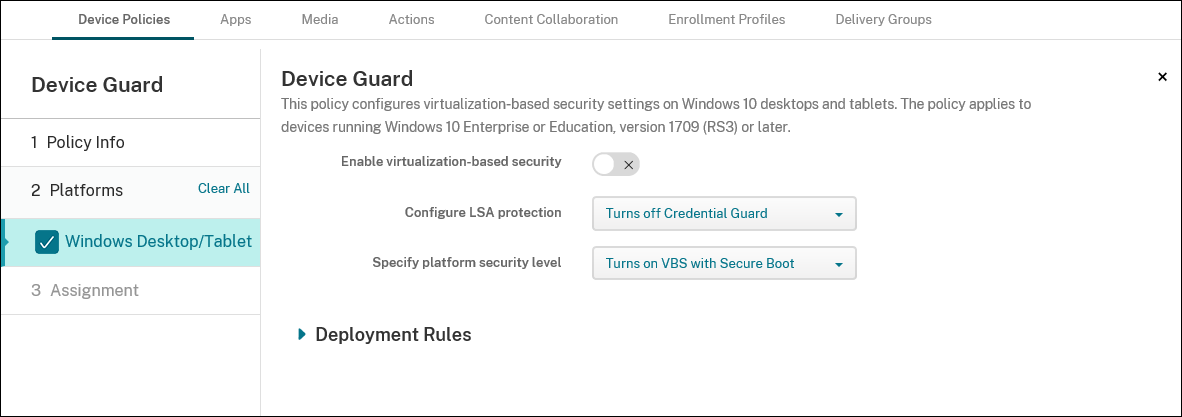-
Endpoint Management integration with Microsoft Endpoint Manager
-
Certificates and authentication
-
Client certificate or certificate plus domain authentication
-
Authentication with Azure Active Directory through Citrix Cloud™
-
Authentication with Azure Active Directory Group-Based Administration
-
Authentication with Azure Active Directory through Citrix Gateway for MAM enrollment
-
Authentication with Okta through Citrix Gateway for MAM enrollment
-
Authentication with an on-premises Citrix Gateway through Citrix Cloud
This content has been machine translated dynamically.
Dieser Inhalt ist eine maschinelle Übersetzung, die dynamisch erstellt wurde. (Haftungsausschluss)
Cet article a été traduit automatiquement de manière dynamique. (Clause de non responsabilité)
Este artículo lo ha traducido una máquina de forma dinámica. (Aviso legal)
此内容已经过机器动态翻译。 放弃
このコンテンツは動的に機械翻訳されています。免責事項
이 콘텐츠는 동적으로 기계 번역되었습니다. 책임 부인
Este texto foi traduzido automaticamente. (Aviso legal)
Questo contenuto è stato tradotto dinamicamente con traduzione automatica.(Esclusione di responsabilità))
This article has been machine translated.
Dieser Artikel wurde maschinell übersetzt. (Haftungsausschluss)
Ce article a été traduit automatiquement. (Clause de non responsabilité)
Este artículo ha sido traducido automáticamente. (Aviso legal)
この記事は機械翻訳されています.免責事項
이 기사는 기계 번역되었습니다.책임 부인
Este artigo foi traduzido automaticamente.(Aviso legal)
这篇文章已经过机器翻译.放弃
Questo articolo è stato tradotto automaticamente.(Esclusione di responsabilità))
Translation failed!
Device Guard device policy
Device Guard is a security feature available with Windows 10 and Windows 11. This feature enables virtualization-based security by using the Windows Hypervisor to support security services on the device. The Device Guard policy enables security features such as secure boot, UEFI lock, and virtualization.
Prerequisites
- Windows 10 and Windows 11 Desktops and Tablets with an Enterprise or Education license
-
Device Guard enabled in Windows
For more information on Device Guard, see https://docs.microsoft.com/en-us/windows/access-protection/credential-guard/credential-guard-manage.
To add or configure this policy, go to Configure > Device Policies. For more information, see Device policies.
Windows Desktop and Tablet settings

- Enable virtualization-based security: Disable or enable virtualization-based security features. Virtualization-based security uses the Windows Hypervisor to support security services.
- Configure LSA protection: Lets you configure Credential Guard. This setting lets users turn on Credential Guard with virtualization-based security to help protect credentials on the next restart. Options are Turns off Credential Guard, Turns on Credential Guard with UEFI lock, and Turns on Credential Guard without UEFI lock. Default is Turns off Credential Guard.
- Specify platform security level: Lets you specify the platform security level on the next restart. Options are Turns on VBS with Secure Boot and Turns on VBS with Secure Boot and direct memory access. Default is Turns on VBS with Secure Boot.
Citrix Endpoint Management queries a device to determine whether the virtualization-based security settings match the settings on the server. If the security settings match, Citrix Endpoint Management doesn’t deploy this policy to the device. If the security settings don’t match, Citrix Endpoint Management deploys the policy.
Share
Share
In this article
This Preview product documentation is Citrix Confidential.
You agree to hold this documentation confidential pursuant to the terms of your Citrix Beta/Tech Preview Agreement.
The development, release and timing of any features or functionality described in the Preview documentation remains at our sole discretion and are subject to change without notice or consultation.
The documentation is for informational purposes only and is not a commitment, promise or legal obligation to deliver any material, code or functionality and should not be relied upon in making Citrix product purchase decisions.
If you do not agree, select I DO NOT AGREE to exit.